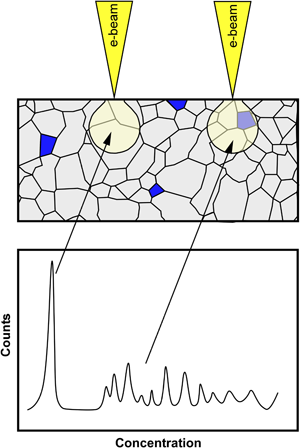Published online by Cambridge University Press: 08 September 2022

The solubility limit of carbon in α-Al2O3 (alumina) equilibrated at 1,600°C under He in a graphite furnace was measured by wavelength-dispersive spectroscopy. Undoped alumina and alumina containing carbon at a concentration resulting in the precipitation of a second phase were prepared and equilibrated at 1,600°C. The undoped alumina was used to quantify the amount of carbon deposited on the surface of samples because of hydrocarbon contamination in the electron microscope, and this background level was removed from the signal measured from carbon-doped samples. The solubility limit of carbon in alumina was found to be 5,300 ± 390 at. ppm, and it is believed that carbon substitutes oxygen as an anion and is charge-compensated by oxygen vacancies. Doping alumina with carbon at concentrations below the solubility limit does not impede densification and reduces grain growth. Doping above the solubility limit hinders densification during sintering.
To send this article to your Kindle, first ensure no-reply@cambridge.org is added to your Approved Personal Document E-mail List under your Personal Document Settings on the Manage Your Content and Devices page of your Amazon account. Then enter the ‘name’ part of your Kindle email address below. Find out more about sending to your Kindle. Find out more about saving to your Kindle.
Note you can select to save to either the @free.kindle.com or @kindle.com variations. ‘@free.kindle.com’ emails are free but can only be saved to your device when it is connected to wi-fi. ‘@kindle.com’ emails can be delivered even when you are not connected to wi-fi, but note that service fees apply.
Find out more about the Kindle Personal Document Service.
To save this article to your Dropbox account, please select one or more formats and confirm that you agree to abide by our usage policies. If this is the first time you used this feature, you will be asked to authorise Cambridge Core to connect with your Dropbox account. Find out more about saving content to Dropbox.
To save this article to your Google Drive account, please select one or more formats and confirm that you agree to abide by our usage policies. If this is the first time you used this feature, you will be asked to authorise Cambridge Core to connect with your Google Drive account. Find out more about saving content to Google Drive.